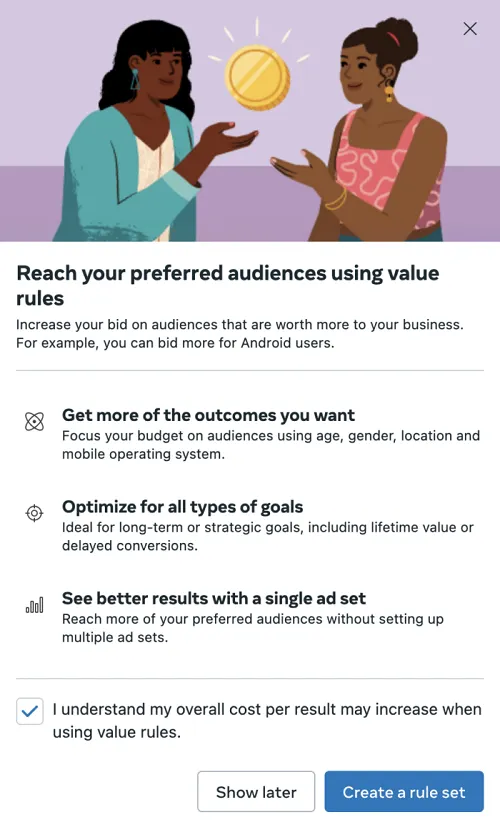Meta has rolled out Value Rules—a powerful feature that allows advertisers to customize bidding strategies for specific audience segments, giving brands more control over ad targeting and return on investment.
Originally available to select advertisers, Value Rules have now been expanded to more accounts, offering a way to adjust bid limits for certain demographics, locations, devices, and ad placements based on their potential lifetime value.

What Are Meta’s Value Rules?
Value Rules enable advertisers to increase or decrease their bids for audience subsets based on data-driven insights. Instead of treating every potential customer equally, brands can assign higher value to users more likely to deliver higher returns.
For example:
- If men aged 25–44 have a 60% higher lifetime value, you can set a rule to increase bids for that group by 60%.
- If women aged 25–44 have a 20% lower lifetime value, you can reduce bids for that segment by 20%.
Meta allows targeting adjustments based on:
- Demographics: Age, gender
- Technology: Operating system
- Location: Country, region, city
- Placement: Instagram feed, Facebook feed, Stories, Reels, Marketplace
This level of control gives marketers the ability to focus spend where it counts most.
How the Rules Work in Practice
Meta applies the rules in the order they’re listed. If rules overlap, only the first applicable rule will be used. For example, if you set:
- +20% bid for women in California
- +50% bid for women using a specific mobile OS
A California woman using that OS would get the +20% bid from Rule 1 only.
This hierarchy means advertisers need to carefully plan rule order to ensure the right audience adjustments are prioritized.
Key Considerations for Advertisers
While Value Rules can deliver more conversions from preferred audiences, cost per result may increase. Meta recommends basing adjustments on hard data, such as Return on Ad Spend (ROAS), rather than assumptions.
Example:
If women generate $115 ROAS and men generate $100 ROAS, women are worth 15% more to the business. Setting a +15% Value Rule would reflect that difference in bidding.
Advertisers can monitor performance in Ads Manager, which provides a breakdown of results by rule.
Comparing Value Rules and Advantage+ Targeting
While Value Rules give advertisers manual control, Meta continues to promote its Advantage+ AI-driven targeting—which automatically identifies high-value audiences without manual parameters.
Recent performance updates show:
- 5% improvement in ad conversions on Instagram
- 3% improvement on Facebook from AI-powered targeting
The takeaway? Test both approaches. Use Value Rules when you have clear, data-backed audience insights, and consider Advantage+ when you want AI to uncover new opportunities outside your manual targeting.
Best Practices for Using Meta’s Value Rules
- Leverage Historical Data: Identify audience segments with consistently higher conversion value.
- Prioritize Rules Thoughtfully: Rule order impacts which bids get applied.
- Test Against AI Targeting: Run split tests comparing Value Rules to Advantage+.
- Monitor Closely: Use Ads Manager breakdowns to refine or remove underperforming rules.
Final Thoughts
Meta’s Value Rules represent a shift toward precision bidding—offering advertisers more granular control over who sees their ads and how much they’re willing to pay for each click or conversion.
For brands with strong first-party data, Value Rules can be a game-changer, maximizing ROI by focusing budget where it matters most. However, success depends on disciplined data analysis and strategic execution.




